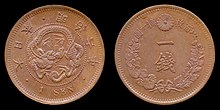1 sen coin
Aside from an alloy change and a new rice stalk wreath design, one sen coins remained the same weight and size for the remainder of the era.
The situation changed when World War I broke out under Emperor Taishō as rising metal costs led to a size and weight reduction.
Emperor Shōwa took the throne in 1926, and Japan was pushed into a militaristic regime by the early 1930s causing metals to be set aside for wartime conditions.
One sen coins were made lighter and were reduced in size as World War II raged on causing a demand for material to make military supplies.
[3] This new coinage gave Japan a western style decimal system based on units of yen, which were broken down into subsidiary currency of sen, and rin.
[10] When production resumed in 1880 (year 13), the scales on the obverse dragon design were changed from a square to a V-shaped pattern.
[10] As with several other denominations it's possible that non circulating one sen dragon coins were made again in 1892 (year 25) for display at the World's Columbian Exposition.
[11][16][b] A rice stalk wreath was chosen to replace the dragon, while the reverse side of the coin received a sunburst design.
At the same time rising metal costs to produce one sen coins became an issue, and their large size had made them difficult to distribute.
One sen coins were minted again during Emperor Shōwa's 2nd year of reign (1927) using the Taishō era paulownia design.
[24] This action suspended the coinage act of 1897 and allowed the Japanese government to issue temporary subsidiary coins without obtaining approval from the Imperial Diet.
[27] The "crow" design with waves on the obverse, and eight ridge mirrors on the reverse was made by combining submissions from a public offering.
[30] By using aluminum, one sen coins were produced in large amounts as the alloy is naturally soft, did not require annealing, and extended the life of the dies.
[30] The design of the one sen coin changed again in 1941, featuring Mount Fuji on the reverse representing Hakkō ichiu.
[34] This remedy was temporary as one sen coins were forcefully discontinued in 1945 due to a depleted tin supply from naval blockades.
[35] A last ditch attempt was made by making one sen coins out of porcelain in the final months of the war.
[11][34][35] One sen coins were officially demonetized at the end of 1953 when the Japanese government passed a law abolishing subsidiary coinage in favor of the yen.
The dates all begin with the Japanese symbol 明治 (Meiji), followed by the year of his reign the coin was minted.
In general, coins dated towards the end of the Meiji era (1898 to 1902) are worth slightly more than those made under Emperor Taishō.



Design 1 - (1873–1892)

Design 2 - (1898–1909)

Design 1 - (1913–1915)

Design 2 - (1916–1924)